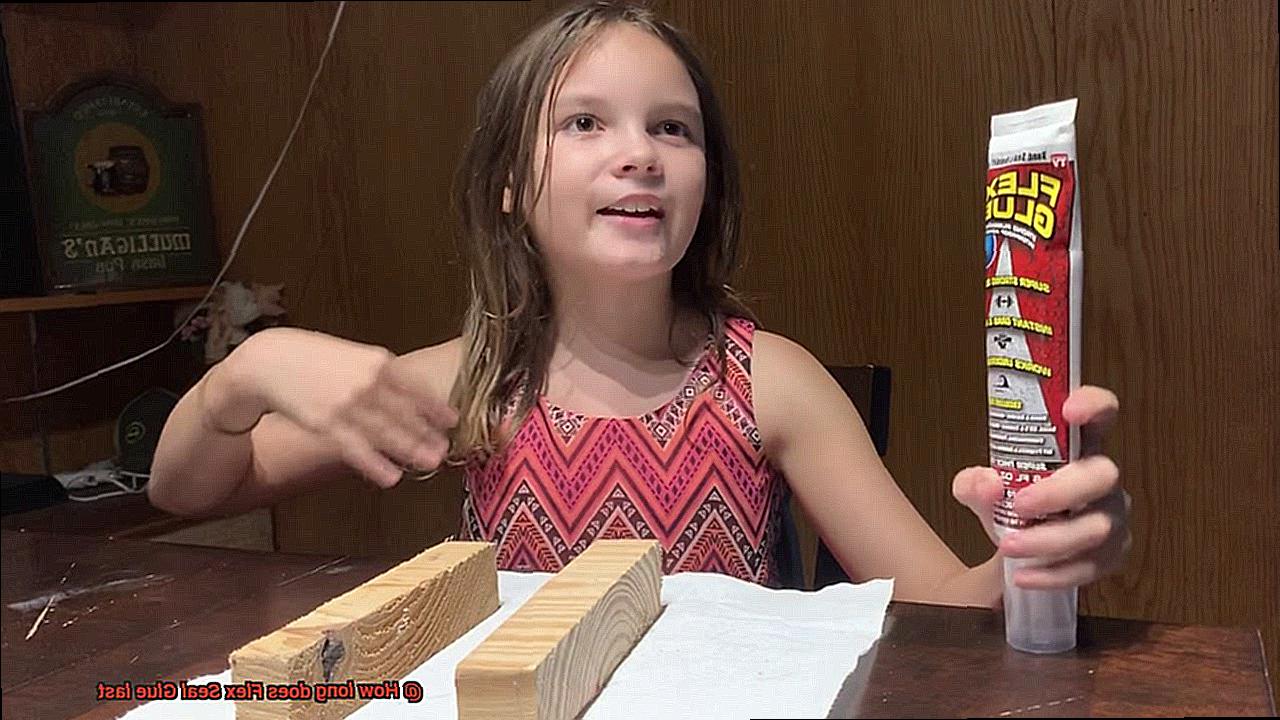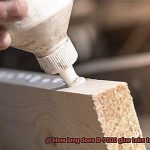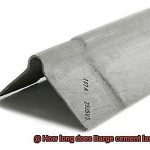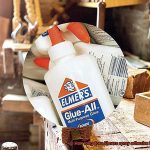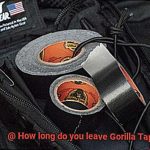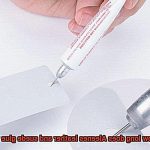It’s the superhero of adhesives, swooping in to save the day when things fall apart. But how long can this glue really keep it together?
Whether you’re fixing a busted pipe, rescuing a shattered trinket, or taking on a crafty project, you want to know that your adhesive will stand the test of time. In this blog post, we’re going to dig deep into the staying power of Flex Seal Glue.
So if you’re itching to find out just how long this adhesive dynamo can go, buckle up and get ready for some sticky revelations.
Factors Affecting the Longevity of Flex Seal Glue
Contents
- 1 Factors Affecting the Longevity of Flex Seal Glue
- 2 Proper Application Techniques for Flex Seal Glue
- 3 Drying Time for Flex Seal Glue
- 4 Durability and Resistance of Flex Seal Glue
- 5 Maximizing the Lifespan of the Bond Created by Flex Seal Glue
- 5.1 Step 1: Prepare and Clean Surfaces
- 5.2 Step 2: Ensure Surfaces Are Dry
- 5.3 Step 3: Apply an Even Layer of Flex Seal Glue
- 5.4 Step 4: Apply Firm Pressure
- 5.5 Step 5: Allow Proper Curing Time
- 5.6 Step 6: Protect From Environmental Factors
- 5.7 Step 7: Regular Maintenance and Care
- 5.8 Step 8: Reinforce as Needed
- 6 Cleaning and Prepping Surfaces Before Applying Flex Seal Glue
- 7 Storing Flex Seal Glue for Maximum Effectiveness
- 8 Examples of Different Applications Where Flex Seal Glue Can Be Used
- 9 Conclusion
Flex Seal Glue has gained popularity for its unrivaled durability and effectiveness. However, to ensure your bonds stand the test of time, it’s crucial to understand the key factors that can affect the longevity of this adhesive powerhouse. In this comprehensive guide, we will explore the environmental factors, preparation techniques, and application methods that play a pivotal role in maximizing the lifespan of your Flex Seal Glue bonds.
Temperature and Humidity:
Extreme temperatures and high humidity levels can wreak havoc on the adhesive properties of Flex Seal Glue. Excessive heat can render the glue brittle, while high humidity can impede proper drying. To combat these challenges, apply the glue in moderate temperature conditions (around 70°F) and ensure ample ventilation to facilitate optimal drying.
Surface Preparation:
Proper surface preparation is paramount for achieving robust and long-lasting bonds. Thoroughly cleanse the surface, eliminating any dust, grease, or contaminants that could hinder adhesion. It is essential to ensure the surface is completely dry before applying the glue as moisture can compromise the bond. Pay extra attention to porous materials like wood, which may require additional steps such as sanding or priming for optimal adhesion.
Material Compatibility:
While Flex Seal Glue is designed for versatile use, ensuring compatibility with your specific material is crucial for longevity. Consider the material’s porosity, flexibility, and other properties when selecting the appropriate adhesive. This will guarantee a strong bond that lasts even in challenging conditions.
Application Method:
Follow the manufacturer’s instructions meticulously when it comes to application techniques and drying time. Applying too much or too little glue can compromise the bond’s strength and durability. Allow sufficient drying time before subjecting the bond to stress or load-bearing activities, ensuring a solid foundation for long-term performance.
UV Light Exposure:
Although Flex Seal Glue possesses some UV resistance, prolonged exposure to sunlight can still impact its longevity. Whenever possible, shield bonded surfaces from direct sunlight or consider incorporating additional protective coatings to preserve the bond’s life.
Stress and Load-Bearing:
Take into account the intended use and the level of stress your bond will endure. If your project involves heavy loads or constant movement, opt for a stronger adhesive or reinforce the bond with mechanical fasteners. By proactively addressing the demands placed on the bond, you can extend its longevity and reliability.
Regular Inspections and Maintenance:
Periodically inspect bonded surfaces for any signs of weakening or deterioration. Swiftly address any issues by reapplying the glue or making necessary repairs. Regular maintenance ensures that your Flex Seal Glue bonds remain strong and durable over time.
Proper Application Techniques for Flex Seal Glue
Flex Seal Glue is a powerful adhesive that can work wonders when used correctly. In this guide, we will delve into the secrets of proper application techniques to help you achieve the best results with Flex Seal Glue. Get ready to unlock the potential of this adhesive powerhouse.
Surface Preparation – The Foundation of Success
- Cleanliness is key: Ensure the surfaces you intend to bond are free from dirt, grease, and debris by using mild detergent or cleaner. Prepare them like a canvas awaiting a masterpiece.
- Dry it out: Allow the surfaces to air dry completely before proceeding. Moisture can compromise the adhesive’s performance. Patience is a virtue in this crucial step.
Applying with Finesse – Thin Layers for Mighty Bonds
- Less is more: Apply a thin, even layer of Flex Seal Glue to one surface only. Precision is your ally in creating a strong bond.
- Press and hold: Firmly press the two surfaces together immediately after applying the glue to ensure maximum contact. Squeeze tight, like a handshake that seals the deal.
Patience is a Virtue – Allowing for Proper Drying Time
- Timing matters: Drying time varies based on temperature and humidity. Wait at least 24 hours before subjecting the bond to stress or load. Let nature work its magic.
- Clamps or weights for added strength: Securely hold the bonded surfaces together while the glue dries using clamps or weights. A little extra support goes a long way.
Temperature Tango – Avoiding Extremes
- Goldilocks zone: Apply Flex Seal Glue in temperatures between 50°F and 90°F (10°C and 32°C) for optimal performance. Find that sweet spot.
- Steer clear of extreme temperatures: Avoid applying the glue in extremely hot or cold conditions, as it can interfere with curing. Keep it cozy for the best results.
Tidying Up – Removing Excess Glue
- Act swiftly: If excess glue seeps out or you’ve accidentally applied too much, clean it up immediately. Time is of the essence.
- Wipe away the excess: Use a damp cloth to remove excess glue before it dries. For stubborn spots, consult the manufacturer’s recommended solvent. Leave no trace behind.
Storage Savvy – Extending Shelf Life
- Sealed for success: Keep the container tightly sealed to prevent air exposure and maintain the quality of the glue. Guard its potency.
- Cool, dry, and dark: Store Flex Seal Glue in a cool, dry place away from direct sunlight or extreme temperatures. Provide a safe haven.
Drying Time for Flex Seal Glue
Temperature and humidity play a crucial role in the drying process of Flex Seal Glue. Just like Goldilocks searching for the perfect porridge, this adhesive prefers a temperate environment. If it’s too cold, you may find yourself waiting longer than expected for the glue to dry. On the other hand, high humidity levels can make it feel like watching paint dry on a rainy day. So, ensure that you’re working in conditions that are just right to achieve optimal results.
Now, let’s talk thickness. While Flex Seal Glue may dry to the touch within 30 minutes to an hour, don’t be fooled—this is merely the initial drying time. To attain maximum strength and durability, allow the glue to cure for a minimum of 24 hours before subjecting it to any stress or load. Patience is key when it comes to creating bonds that can withstand the test of time.
Materials also play a significant role in determining drying time. Flex Seal Glue is like a chameleon, able to adhere to various surfaces such as wood, metal, plastic, ceramic, fabric, and more. However, different materials may require different drying times for optimum bonding strength. To ensure success, consult the manufacturer’s instructions for specific recommendations regarding drying time for different materials.
Durability and Resistance of Flex Seal Glue
Flex Seal Glue is a game-changer when it comes to durability and resistance. This incredible adhesive is designed to withstand the toughest conditions, making it the perfect choice for all your DIY projects.
Let’s start with its resistance to water. Unlike other adhesives that crumble when they come into contact with moisture, Flex Seal Glue holds strong. It can handle exposure to water, making it ideal for repairing outdoor furniture, water tanks, or even boats. No need to worry about your repairs falling apart when it rains or when your items get splashed.
But that’s not all – Flex Seal Glue is also a master at conquering extreme temperatures. Whether it’s scorching hot or freezing cold, this adhesive won’t let you down. It can withstand both ends of the temperature spectrum without losing its grip. So go ahead and use it in any climate or environment without worrying about your repairs giving in to the elements.
But what about chemicals? Flex Seal Glue is like a superhero in that department too. It resists common household chemicals and even some industrial substances. Say goodbye to worries about spills or contact with harsh chemicals – this glue has got you covered.
Oh, and did we mention that Flex Seal Glue is also resistant to UV rays? That’s right, it won’t degrade or become brittle when exposed to sunlight. So feel free to use it on items that will be basking in the sun all day long without worrying about your repairs falling apart.
And let’s not forget about physical durability. Flex Seal Glue creates a flexible bond that can withstand movement and vibrations. It can handle expansion and contraction without losing its adhesive properties. So whether you’re fixing automotive parts or household appliances, you can trust that Flex Seal Glue will keep things together.
It’s important to note that the durability and resistance of Flex Seal Glue may vary depending on the specific application and surface being repaired. So be sure to follow the manufacturer’s instructions for surface preparation, curing time, and proper application techniques to ensure the best results.
Maximizing the Lifespan of the Bond Created by Flex Seal Glue
In this article, we’ll explore how to maximize the lifespan of the bond created by Flex Seal Glue, providing you with tips and techniques to achieve durable and long-lasting results.
Step 1: Prepare and Clean Surfaces
Before applying Flex Seal Glue, it’s crucial to ensure that the surfaces being bonded are clean and free from any dust, dirt, or debris. Taking a few moments to wipe down the surfaces with a clean cloth or paper towel will remove any potential barriers to bonding.
Step 2: Ensure Surfaces Are Dry
Moisture can interfere with the bonding process, so it’s essential to make sure that both surfaces are completely dry before applying the glue. You can use a hairdryer or allow the surfaces to air dry naturally before proceeding.
Step 3: Apply an Even Layer of Flex Seal Glue
To achieve a strong bond, it’s important to apply an even layer of Flex Seal Glue on both surfaces being bonded. Using a brush or applicator, spread the glue evenly, ensuring that it covers the entire surface area. Avoid applying excess glue, as this can lead to messiness and longer curing times.
Step 4: Apply Firm Pressure
After applying the glue, press the surfaces firmly together. Applying pressure ensures maximum contact between the adhesive and the surfaces being bonded. You can use clamps, weights, or simply your hands to maintain consistent pressure for the recommended curing time.
Step 5: Allow Proper Curing Time
Proper curing time is vital for a strong and long-lasting bond. Follow the instructions provided by Flex Seal Glue for the recommended duration. During this time, avoid disturbing or moving the bonded surfaces to allow the adhesive to fully set and create a robust bond.
Step 6: Protect From Environmental Factors
To further maximize the lifespan of the bond, protect it from excessive moisture, heat, or cold. These elements can weaken the bond over time. Consider using a sealant or protective coating over the bonded area for added protection.
Step 7: Regular Maintenance and Care
Regular maintenance and care are essential in extending the lifespan of the bond created by Flex Seal Glue. Avoid exposing the bonded area to harsh chemicals or abrasive materials that could damage or weaken the bond. Clean the area gently using mild soap and water when necessary.
Step 8: Reinforce as Needed
If the bond starts to weaken over time, don’t worry. Simply reapply Flex Seal Glue following the same steps mentioned earlier to reinforce the bond and restore its durability.
Cleaning and Prepping Surfaces Before Applying Flex Seal Glue
Cleaning and prepping surfaces before applying Flex Seal Glue is an essential step in ensuring a strong and long-lasting bond. Without proper preparation, the adhesive properties of the glue may be hindered, resulting in a weaker bond that is prone to failure. To achieve the best results, follow these steps to clean and prep your surfaces:
- Clean the surfaces: Start by removing any dirt, dust, grease, or oil using a mild detergent and water. Gently scrub the surface with a scrub brush or sponge to ensure a thorough cleaning. Rinse the surface thoroughly and allow it to dry completely before moving on.
- Address tough stains or mold: If you’re dealing with heavily soiled surfaces or mold and mildew growth, a stronger cleaning solution may be necessary. Look for commercial cleaners specifically designed for these tough stains and follow the manufacturer’s instructions for safe usage. Make sure to rinse the surface thoroughly and allow it to dry completely before proceeding.
- Sand rough surfaces: For rough or uneven surfaces, sanding may be necessary to create a smooth and even surface for the glue to adhere to. Use a sanding block or sandpaper with a fine grit to gently smooth out the surface. Be careful not to oversand or damage the surface while doing so.
- Remove loose particles: After cleaning and sanding, make sure to remove any loose particles or debris from the surface. Use a soft brush or cloth to wipe away any remaining dust or debris. This will ensure that the surface is clean and ready for bonding.
- Consider material-specific prepping: Different materials may require specific prepping methods to optimize adhesion. For example, if you’re working with plastic, lightly roughening the surface using sandpaper can improve adhesion. If you’re working with metal, using a primer designed for metal surfaces may be necessary.
- Dry thoroughly: Before applying Flex Seal Glue, ensure that the surfaces are completely dry. Moisture can hinder the bonding process and reduce the effectiveness of the glue. Allow sufficient time for drying, especially if you have used water or any cleaning solutions during the prepping process.
Storing Flex Seal Glue for Maximum Effectiveness
Are you tired of weak adhesives and messy glue spills? Look no further than Flex Seal Glue, the ultimate solution for all your bonding needs. Renowned for its unparalleled strength and durability, Flex Seal Glue is a game-changer. But did you know that proper storage is crucial to maximize its effectiveness? Let’s delve into the key considerations and best practices for storing this incredible adhesive.
First and foremost, temperature plays a pivotal role in maintaining the potency of Flex Seal Glue. To keep it at its prime, store it in a cool, dry place, far away from direct sunlight and extreme temperatures. Let’s keep it cool, folks. Heat can be its nemesis, causing the glue to dry out or become less effective.
Humidity is another factor to consider when storing Flex Seal Glue. Excessive moisture can impact its adhesive properties, leading to clumping or a loss of strength. Say no to moisture. Store the glue away from sources of dampness and ensure a dry environment to maintain its optimal condition.
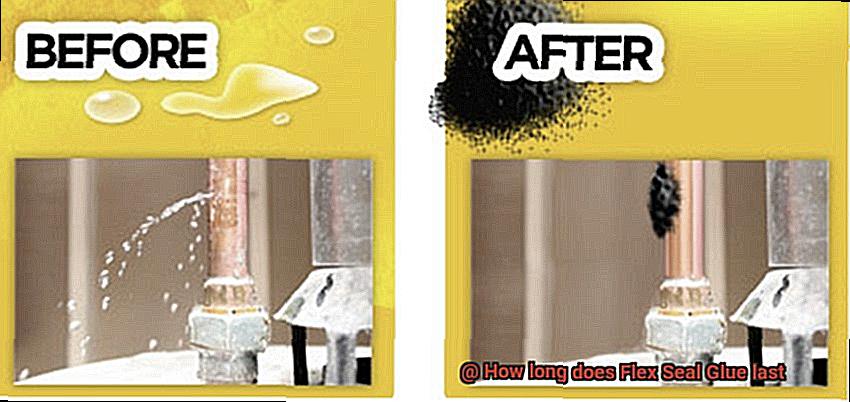
When it comes to container type, an airtight container is your best friend. Alternatively, tightly seal the tube after each use. This prevents air from entering and drying out the glue, preserving its adhesive power for longer periods. Say goodbye to dried-up glue.
Of course, safety should always be a priority. Keep Flex Seal Glue out of reach of children and pets. Its strong adhesive properties can be harmful if ingested or come into contact with eyes or skin. Store it in a secure location where unauthorized individuals cannot access it.
Now, let’s talk about positioning. Storing Flex Seal Glue upright is essential to prevent leakage or spillage. By keeping it in an upright position, you ensure that the glue remains intact and ready for use whenever you need it. Let’s stand tall.
Last but not least, regularly check the expiration date. Over time, the adhesive properties may decrease, rendering it less efficient. Don’t compromise on effectiveness. Replace any expired or old glue with a fresh supply to guarantee optimal results.
Examples of Different Applications Where Flex Seal Glue Can Be Used
Are you tired of dealing with leaky pipes, broken household items, or damaged car parts? Look no further than Flex Seal Glue, the superhero adhesive that can tackle a wide range of repair projects. In this blog post, we will explore the unlimited applications where Flex Seal Glue can be used, providing you with an in-depth understanding of its versatility and durability.
Plumbing Repairs:
Flex Seal Glue is not just your average adhesive; it’s the ultimate savior for repairing leaky pipes and plumbing fixtures. With its mighty strength and durable bond, it fearlessly seals small cracks or leaks, preventing further water damage and ensuring a long-lasting repair that can withstand the test of time.
Automotive Repairs:
In the fast-paced world of automobiles, Flex Seal Glue shines as the go-to solution for fixing minor damages on car parts. Whether it’s plastic bumpers yearning for restoration, side mirrors longing to be whole again, or interior trim pieces desperate for revival, this adhesive creates a bond so strong it can endure the vibrations and stresses experienced by these components without breaking a sweat.
Household Repairs:
Bid farewell to broken ceramic or glass objects with Flex Seal Glue by your side. This adhesive wields its power swiftly and securely, allowing you to seamlessly repair cherished vases, treasured dishes, or even beloved wooden furniture with loose joints or shattered dreams.
Crafting and DIY Projects:
Flex Seal Glue is not just a hero in the world of repairs; it’s also a versatile artist when it comes to crafting and DIY projects.
With its ability to bond various materials together, it becomes your trusty sidekick in creating or repairing items like enchanting handbags, stylish shoes, awe-inspiring costumes, captivating picture frames, or even breathtaking sculptures.
From fabric to foam, leather to plastic, this adhesive can transform your visions into reality.
Construction Applications:
The construction industry welcomes the undeniable capabilities of Flex Seal Glue with open arms.
It bravely bonds different materials such as concrete, metal, wood, or stone, making it an essential tool for repairing cracks in concrete structures, securing metal fixtures or attachments, or even uniting tiles or stones for flooring or wall installations. With Flex Seal Glue, construction projects become a seamless symphony of strength and reliability.
Outdoor Repairs:
Flex Seal Glue fearlessly embraces the great outdoors, proving its mettle in the face of water and weathering. Whether you need to mend a wounded garden hose, revive weather-beaten outdoor furniture, or seal the cracks in outdoor structures like resilient sheds or formidable fences, this adhesive promises to be your unyielding shield against nature’s relentless onslaught.
t9Uj2-T_3G0″ >
Conclusion
Flex Seal Glue is a reliable adhesive that can withstand the test of time.
Its durability ensures that your repairs will last for an extended period. With proper application and maintenance, Flex Seal Glue can remain intact for years, providing you with peace of mind and saving you from the hassle of frequent repairs.
Whether you’re fixing a leaky pipe or securing loose tiles, Flex Seal Glue has got you covered.

